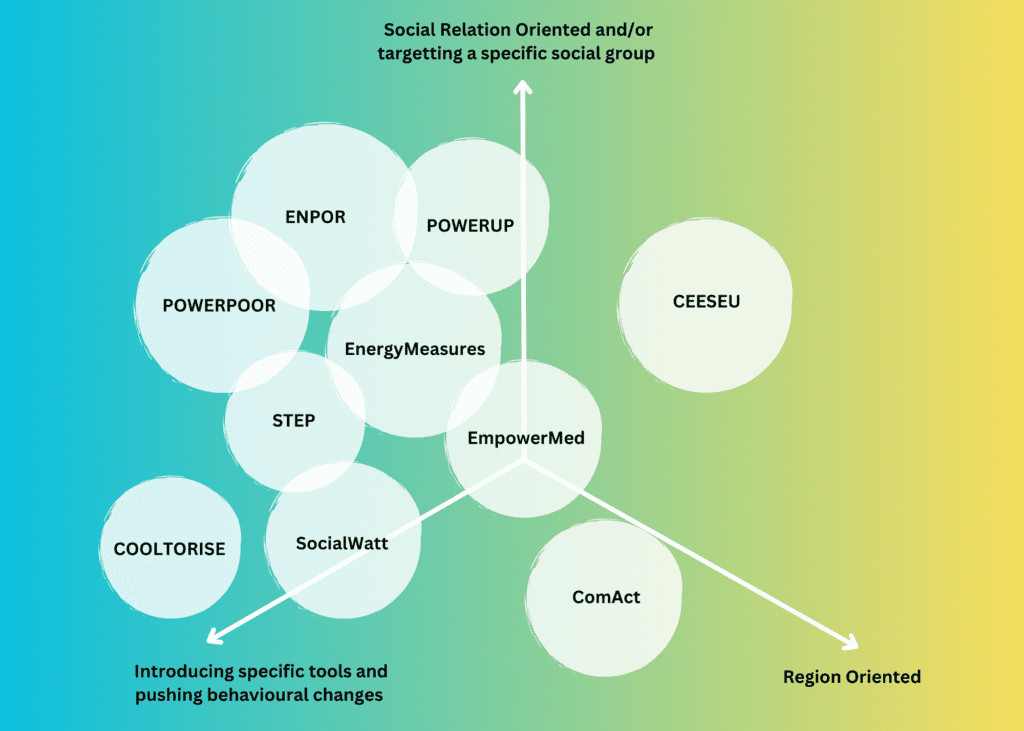When we submitted the EnergyMeasures project to the EU-commission, it was under the Horizon2020 call H2020-LC-SC3-2018-2019-2020, that focused on building a low-carbon, climate resilient future, which is secure, clean and efficient in energy. Since there is no single way to achieve this aim, the call gave way to the creation of multiple, autonomous projects, each tackling the challenge of energy poverty from a different perspective. Still, since they were working towards the same goal, they were related to each other and thus this article aims to highlight the differences and similarities between the projects to show that sometimes the sum of certain parts can be as great as the whole.

The projects which Energy Measures considers sister projects are ComAct, COOLTORISE, EmpowerMed, ENPOR, POWER UP, POWERPOOR, SocialWatt, STEP and CEESEU. The article approaches their differentiation by dividing the projects into ones, which focus on social relations or specific social groups, ones that introduce specific behaviors or tools and ones that focus on particular regions. Of course, this divide is not an ultimate approach, but it does give the project matrix some clarity.
Region Oriented Projects
Although all projects target specified European countries, the most region-oriented project is ComAct, which focuses on central and eastern (CEE) as well as southeastern (SEE) European regions and the commonwealth of independent states (CIS)- formerly the Soviet Union. The project works on identifying the underlying causes and developing new approaches to reduce high levels of energy poverty, focusing on reducing energy costs in multi-family apartment buildings. A project which also works in the CEE region is the CEESEU, which, unlike ComAct focuses more on addressing municipalities, public administrators and other decision-making stakeholders. CEESEU develops training materials and guides to promote energy efficiency, sustainable energy and reduced climate emissions. The last project presented on the matrix, which specifies a particular region is EmpowerMed, which takes into account the role women in the Mediterranean play in economy. It also works on reducing energy poverty and its effects on health by connecting women with health practitioners.
Socially Oriented Projects
The projects located in the upper left corner of the matrix all deal with energy poverty through a social approach and by establishing behavioural changes. Nevertheless they differ in the tools they introduce and the social groups they address. Energy Measures, for example, has two complementary and synergistic strands of work. On one hand it works with households and introduces low-cost measures and changes in habits and on the other hand it works with municipalities, housing associations and other key actors to assess how capable they are to alleviate energy poverty. Similarly, POWER UP teams up with energy poor households and local stakeholders (cities, social organisations, utilities companies etc), however the project works to support plans to create and sustain local energy players. The project is developing six pilot schemes across Europe and facilitates replication in other countries. The development of pilot projects is also done by POWERPOOR, but pivots more towards advising energy-poor citizens on how to use alternative financing schemes such as cooperatives or crowdfunding. Like EnergyMeasures, POWERPOOR encourages knowledge exchange and realizes small scale energy efficiency interventions.
Tool Development Projects
Most tool-oriented projects are SocialWatt and STEP. Both projects work on schemes and models, which are innovative and replicable. SocialWatt focuses more on EU utilities and energy suppliers to develop specific tools, while STEP creates a national network of advisors and uses existing channels to reach energy-poor consumers. Also aiming to render energy poverty, but in the private sector is ENPOR, which takes into consideration the need for dedicated actions to identify energy-poor tenants and to understand their needs. Meticulous tool development is adopted by COOLTORISE as well, however this project attends to summer energy poverty. Within COOLTORISE a framework is developed where measures are taken to reduce the impact of heatwaves in low-energy efficient households, so that families can afford to keep their homes adequately cool.
Achieving a low-carbon and climate resilient future is not an easy task especially if there are ongoing geo-political factors, which hinder the reaching of this aim. Nevertheless, with the combined efforts of many projects, which focus on the various aspects of the complex issue of energy poverty, small, but continuous steps can be taken to achieve a more secure, clean and energy efficient Europe.
